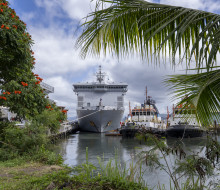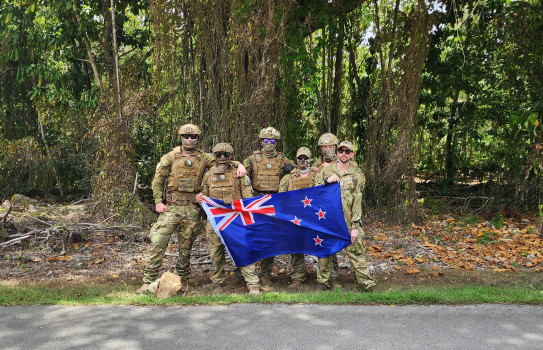
HMNZS Canterbury concludes week-long Fiji deployment
25 July 2025
Unfortunately you are viewing this website on an outdated browser which does not support the necessary features for us to provide an adequate experience. Please switch to a modern browser such as latest version of Google Chrome, Mozilla Firefox, Apple Safari or Microsoft Edge.
Ngā mihi nui
For the first time a Royal New Zealand Air Force (RNZAF) Security Force’s team has been invited to compete in an elite international Advanced Combat Skills Assessment at the United States air base in Guam.
The assessment, at Anderson Air Force Base, tests United States Air Force (USAF) and partner nations’ combat skills and readiness to support air operations in the Pacific.
The team had little idea of what to expect and faced units with up to 400 personnel to select from, many of whom trained year-round for the competition.
Partner-nations faced a steep learning curve adapting to USAF equipment and the Guam climate.
New Zealand was joined by teams from the Royal Australian Air Force, Luftwaffe, and Japan Air Self Defence Force, to compete against the best of the 12 USAF Security Force Squadrons in the Pacific.
The competition kicked off with the combat fitness assessment, which covered a range of measures including maximum weight deadlifts, maximum push ups, leopard crawls, a sprint/drag/carry circuit, power throws, and a 2.4km run.

Advanced Combat Skills Assessment | Royal New Zealand Air Force
Discipline and adherence to instruction were a key component of success, with strict rules and criteria for all movements, and harsh penalties for those failing to adhere to them.
Scoring favoured all measures of success including weight, distance and time, with scoring based on each team’s average.
The combat agility assessment followed, featuring a pack march between various skill stations covering keep-in memory challenges – retaining and remembering information throughout the day’s challenges. Competitors were also tested on their knowledge of CBRN (chemical, biological, radiological and nuclear) drills, weapons, and radio communications.
The event culminated in a run through of the assault course, with teams scored on overall completion time and points added or deducted for the skill stands along the route.
The marksmanship assessment included crossfit-style fitness workout and pistol, rifle, and grenade launcher serials testing recoil management, rapid alignment, target selection, and shooting from various distances and positions.
Each competitor finished the course by running jerry-cans to the finish line. Teams were scored based on overall completion time, with points deducted throughout for missed shots.

Then came the combat endurance assessment. This included a wide array of military skills including land navigation, counter-improvised explosive device practices, combat casualty-care and evacuation, and urban operations.
It culminated with the requirement to defeat of a hostile force using simulated ammunition.
The final assessment was a combative tournament. All teams participated in a randomised, bracket-style elimination contest, consisting of five-minute rounds using Brazilian jiu-jitsu-style submission techniques.
Partner nations faced an uphill battle against the USAF, who were well practiced in the techniques having included them as part of their formal combative programmes. Tenacity and the will to win weren't to be underestimated though, and a New Zealand team with only a day of formal jiu-jitsu training placed 8th out of 16 teams.

While the RNZAF didn't score a podium finish in this year’s competition, there were plenty of Kiwi flags in the top 10 per cent of individual activities during each assessment.
Comments from partner nations and Pacific Air Force’s command highlighted our fighting spirit, sheer tenacity, and an unshakeable sense of humour in the face of adversity.
The opportunity for selection on future teams will require the individual pursuit of excellence, which will enhance collective combat readiness of all our personnel. This will in turn enhance what we can offer the wider RNZAF through our individual readiness training.